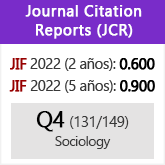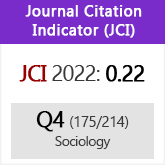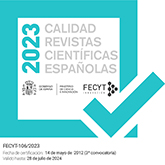La no respuesta en encuestas presenciales realizadas en España
DOI:
https://doi.org/10.3989/ris.2012.02.07Palabras clave:
Encuestas presenciales, Mejora de la cooperación, No respuesta total, RepresentatividadResumen
El paulatino descenso en la cooperación en las encuestas hace peligrar la viabilidad futura de esta herramienta, una de las mejores para el conocimiento de la sociedad. Desde la última década del pasado siglo numerosas investigaciones han estudiado el fenómeno en profundidad, al tiempo que se ha producido una mayor “transparencia” del proceso de recogida de datos al difundirse documentos donde se detallan con precisión los “sucesos” acontecidos durante el trabajo de campo. En este trabajo se analiza la no respuesta de las encuestas presenciales realizadas en España considerando las que seleccionan los entrevistados con rutas y cuotas, así como las que emplean documentos administrativos como el Padrón de Población. El trabajo termina con una serie de estrategias que han demostrado su eficacia para contrarrestar los efectos de la no respuesta.
Descargas
Citas
American Association for Public Opinion Research-AAPOR. 2011. Standard Definitions: Final Dispositions of Case Codes and Outcome Rates for Surveys. AAPOR. Consulta el 13 de junio de 2011 (http://www.aapor.org/AM/Template.cfm?Section=Standard_Definitions&Template=/CM/ContentDisplay.cfm&ContentID=1819).
Benthlehem, J., F. Cobben y B. Schouten. 2011. Handbook of nonresponse in household surveys. Nueva York: Wiley. http://dx.doi.org/10.1002/9780470891056
Berdie, D. R. 1993. "Telephone Survey Response Rates: How high is high enough?." Marketing Research 5:35-44.
Biemer, P. y L. Lyberg. 2003. Introduction to survey quality. Nueva York: Wiley. http://dx.doi.org/10.1002/0471458740 PMid:12664250
Blom, A., P. Lynn y A. Jäckle. 2008. "Understanding cross-national differences in unit non-response: the role of contact data." ISER Working Papers Series 2008-01, noviembre. Colchester: University of Essex. Consultado 11 de junio de 2011 (http://www.iser.essex.ac.uk/publications/working-papers/iser/2008-01).
Bulmer, M., P. J. Sturgis y N. Allum 2009. The Secondary Analysis of Survey Data. Thousand Oaks, CA: Sage.
Bradburn, N. M. 1992. "A Response to the Nonresponse Problem." Public Opinion Quarterly 56:391-397. http://dx.doi.org/10.1093/poq/56.3.391
Campanelli, P., P. Sturgis y S. Purdon. 1997. Can you hear me knocking: An investigation into the impact of interviewers on surveys response rates. Londres: SCPR.
Campanelli, P. y C. Skinner 1997. "Curso sobre 'Handling Non-Response'." Curso impartido por el CASS, Universidad de Southampton. 10-12 de marzo. Southampton.
Centro de Investigaciones Sociológicas. 2011. Barómetro de enero. Estudio 2.859. Madrid: CIS.
Centro de Investigaciones Sociológicas. 2011. Barómetro de febrero. Estudio 2.861. Madrid: CIS.
Centro de Investigaciones Sociológicas. 2011. Barómetro de marzo. Estudio 2.864. Madrid: CIS.
Centro de Investigaciones Sociológicas. 2011. Barómetro de abril. Estudio 2.865. Madrid: CIS.
Centro de Investigaciones Sociológicas. 2011. Barómetro de mayo. Estudio 2.888. Madrid: CIS.
Centro de Investigaciones Sociológicas. 2010. Barómetro de junio. Estudio 2.905. Madrid: CIS.
De Leeuw, E. y W. de Heer. 2002. "Trends in household survey nonresponse: a longitudinal and international comparison." Pp. 41-54 en Survey Nonresponse, editado por Robert M. Groves et al. Nueva York: Wiley.
DeMaio, T. 1980. "Refusals: Who, where and why." Public Opinion Quarterly 44:222-233. http://dx.doi.org/10.1086/268586
Díaz de Rada, V. 2000. Problemas originados por la no respuesta en investigación social: Definición, control y tratamiento. Pamplona: Universidad Pública de Navarra.
Díaz de Rada, V. 2005. Manual del trabajo de campo en la encuesta. Madrid: CIS, Cuadernos Metodológicos 36.
Díaz de Rada, V. 2010. Comparación entre los resultados proporcionados por encuestas telefónicas y personales: el caso de un estudio electoral. Madrid: CIS.
Dillman, Don A. 1978. Mail and Telephone Surveys. Nueva York: Willey.
Dillman, Don A., E. Singer, J. R. Clark y J. B. Treat. 1996. "Effects of Benefits Appeals, Mandatory Appeals, and Variations in Statements of Confidentiality on Completion Rates for Census Questionnaires." Public Opinion Quarterly 60:376-389. http://dx.doi.org/10.1086/297759
Dillman, D. A., J. D. Smyth y L. M. Christian. 2009. Internet, Mail and Mixed-Mode Surveys: The Tailored Design Method. Nueva York: Wiley.
Eustat. 2008. Estudio y ajuste de la no respuesta en las encuestas a hogares. Vitoria: Eustat.
Goyder, J. 1985. "Face to face interviews and mailed questionnaires: The Net difference in response rate." Public Opinion Quarterly 49:234-252. http://dx.doi.org/10.1086/268917
Goyder, J. 1987. The Silent Minority. Cambridge: Polity Press.
Goyder, J. 1994. "An experiment with cash incentives on a personal interview survey." Journal of the Market Research Society 36:361-366.
Goyder, J. y J. McKenzie Leiper 1985. "The decline in survey response: A social values interpretation." Sociology 19:55-71. http://dx.doi.org/10.1177/0038038585019001006
Groves, R. M. y R. B. Cialdini 1992. "Toward a Useful Theory of Survey Participation." Pp. 105-120 en Proceedings of the Section on Survey Research Methods. American Statistical Association.
Groves, R. M., Robert B. Cialdini y Mick P. Couper. 1992. "Understanding the decision to Participate in a Survey." Public Opinion Quarterly 56:475-495. http://dx.doi.org/10.1086/269338
Groves, R. M. y Mick P. Couper 1992. "Correlates of Nonresponse in Personal Visit Surveys." Pp. 102-110 en Proceedings of the Section on Survey Research Methods, American Statistical Association.
Groves, R. M. y Mick P. Couper 1993. "Unit Nonresponse in Demographic Surveys." Pp. 239-619 en Proceedings of the Bureau of the Census 1993 Annual Research Conference. Washington: Bureau of the Census.
Groves, R. M. y Mick P. Couper 1998. Nonresponse in Household Interview Surveys. Nueva York: Wiley.
Groves, R. M., Don A. Dillman, Jon L. Eltinge y J. A. Roderick Little. 2002. Survey Nonresponse. Nueva York: Wiley.
Groves, R. M., E. Singer y A. Corning 2000. "Leverage-Salience theory of survey participation." Public Opinion Quarterly 64:299-308. http://dx.doi.org/10.1086/317990 PMid:11114270
Groves, R. M. y E. Peytcheva. 2008. "The impact of nonresponse rates on nonresponse bias." Public Opinion Quarterly 72:167-189. http://dx.doi.org/10.1093/poq/nfn011
Hox, J. J. y E. Deleeuw. 1994. "A Comparison of Nonresponse in Mail, Telephone, and Face-to-face Surveys." Quality and Quantity 28:329-344. http://dx.doi.org/10.1007/BF01097014
Instituto Nacional de Estadística. 2003. Evaluación de la falta de respuesta en la Encuesta de empleo del tiempo (TIC-H-2010). Madrid: INE. Consultado 16 de junio de 2011 (http://www.ine.es/daco/daco42/empleo/evalfr.pdf).
Instituto Nacional de Estadística. 2009. Evaluación de la falta de respuesta en la Encuesta Europea de Salud 2009 (TIC-H-2010). Madrid: INE. Consultado 16 de junio de 2011 (http://www.ine.es/daco/daco42/techog/evalfr10.pdf).
Instituto Nacional de Estadística. 2010a. Evaluación de la falta de respuesta en la Encuesta sobre equipa-miento y uso de tecnologías de la información y comunicación en los hogares, 2010 (TIC-H-2010). Madrid: INE. Consultado 16 de junio de 2011 (http://www.ine.es/daco/daco42/techog/evalfr10.pdf).
Instituto Nacional de Estadística. 2010b. Evaluación de la calidad de los datos de la Encuesta de Población Activa 2010. Madrid: INE. Consultado 16 de junio de 2011 (http://www.ine.es/docutrab/eval_epa/evaluacion_epa10.pdf).
Instituto Nacional de Estadística. 2010c. Encuesta de Tecnologías de la Información en los Hogares. Madrid: INE. www.ine.es.
Laurie, H., R. Smith y L. Scott. 1997. "Strategies to Reducing Non-Response in a Longitudinal Panel Survey." Working Papers on the ESCR Research Centre on Micro-Social Change. Paper 97-12. University of Essex. Colchester.
Lin, I. y N. Cate Schaeffer. 1995. "Using Survey Participants to Estimate the Impact of Nonparticipation." Public Opinion Quarterly 59:236-258. http://dx.doi.org/10.1086/269471
Losilla, J. 2005. "Recogida de datos de una encuesta continua dirigida a los hogares: la EPA." en Trabajos de Campo en las encuestas del INE. Curso impartido en la Escuela de Estadística de las Administraciones públicas del Instituto Nacional de Estadística. 21-23 de junio.
Lynn, P. 1996. "Weighting for Non-Response." Pp.205-214 en Survey and Statistical Computing 1996, editado por R. Banks. Association for Survey Computing: Londres.
Lynn, Peter et al. 2002. "The effect of extended interview efforts on nonresponse bias." Pp. 135-148, en Survey Nonresponse, editado por Robert M. Groves et al. Nueva York: Wiley.
Kiecolt, K. J. y E. L. Nathan 1985. Secondary analysis of survey data. Thousand Oaks, CA: Sage Publications.
Kish, L. 1965. Survey Sampling. Nueva York: Wiley. Versión española en 1965: Muestreo de encuestas. México: Trillas.
Matsuo, H., J. Billiet, F. Loosveldt, F. Berglund y Ø Kleven. 2010. "Measurement and adjustment of non-response bias based on non-response surveys: the case of Belgium and Norway in the European Social Survey Round 3." Survey Research Methods 4:121-126.
Metroscopia 2007. Informe técnico de la tercera ola en España (End of fieldwork report Spain. European Social Survey, 3rd round). Consultado 22 de julio de 2011 (http://www.upf.edu/ess/tercera-ed/).
Metroscopia 2009. Informe técnico de la cuarta ola en España (Final field report of the 4th round of ESS). Consultado el 22 de julio de 2011 (http://www.upf.edu/ess/_pdf/4a-ola/trabajo_campo/ESS08_FinalFieldReport.pdf).
Ministerio de Sanidad y Consumo 2006. Encuesta Nacional de Salud 2006. Metodología detallada. Madrid: Ministerio de Sanidad y Consumo.
Morton-Williams, J. 1993. Interviewer Approaches. Vermont: Darmouth.
National Centre for Social Research. 1999. How to Improve Survey Response Rates. A guide for Interviewers on the Doorstep (vídeo) y How to Improve Survey Response Rates. A guide for Interviewers on the Doorstep (guía de utilización del vídeo). Londres: Sage.
Núñez Villuendas, A. 2005. "Incidencias de la entrevista personal en la investigación por encuesta." Revista Española de Investigaciones Sociológicas 109:219-236. http://dx.doi.org/10.2307/40184672
Peytchev, A., R. K. Baxter y L. R. Carley-Baxter. 2009. "Not All Survey Effort is Equal: Reduction of Nonresponse Bias and Nonresponse Error." Public Opinion Quarterly 73:785-806. http://dx.doi.org/10.1093/poq/nfp037
Riva, C., M. Torcal y L. Morales 2010. "Estrategias para aumentar la tasa de respuesta y los resultados de la Encuesta Social Europea en España." Revista Internacional de Sociología 68:603-635. http://dx.doi.org/10.3989/ris.2008.12.17
Rossi, P. H., James W. Wright y A. B. Anderson. 1983. "Sample surveys: History, current practice, and future prospects." Pp. 1-20 en Handbook of survey research, editado por Peter H. Rossi, James D. Wright, y Andy B. Anderson. San Diego: Academic Press.
Sánchez Carrión, J. J. 2000. La bondad de la encuesta: el caso de la no respuesta. Madrid: Alianza.
Schmeets, H. 2010. "Increasing Response Rates and the Consequences in the Dutch Parliamentary Election Study 2006." Field Methods 22:397-412. http://dx.doi.org/10.1177/1525822X10381031
Singleton, R. y B. Stratis 2005. Approaches to social research. Nueva York: Oxford University Press.
Skaland, B. 2011. "An alternative to the response rate for measuring a survey's realization of the tarjet population." Public Opinion Quarterly 75:89-98. http://dx.doi.org/10.1093/poq/nfq072
Smith, T. W. 1981. The Hidden 25 percent: An Analysis of Nonresponse of the 1980 General Social Survey. GSS Technical Report 25. Chicago: National Opinion Research Center.
Smith, T. W. 1995. "Trends in Nonresponse Rates." International Journal of Public Opinion Research 7:157-171. http://dx.doi.org/10.1093/ijpor/7.2.157
Smith, T. W. 2007. "Survey non-response in cross-national perspective: the 2005 ISSP non response survey." Survey Research Methods 1:45-54.
Statistics Sweden 1999. Journal of Official Statistics. Special issue on Survey Nonresponse 2.
Statistics Sweden 2001. Journal of Official Statistics. Special issue on Survey Nonresponse 2.
Steeh, C. G. 1981. "Trends in Nonresponse Rates: 1952-1979." Public Opinion Quarterly 45:40-57. http://dx.doi.org/10.1086/268633
Sturgis, P. y P. Campanelli .1997. "Interviewer Intuition?: The Ability of Interviewers to Predict the Likelihood of Achieving an Interview before making Contact with Address Residents." Survey Methods Centre Newsletter 17: 3-6.
Stoop, I. A. 2005. The Hunt for the Last Respondent. Nonresponse in Sample Surveys. The Hague: Social and Cultural Planning Office of the Netherlands.
Stoop, I. Kele; J. Billiet, A. Koch y R. Fitzgerald. 2010. Improving Survey Response: Lessons Learned from the European Social Survey. Nueva York: Wiley.
Torcal, M., L. Morales y C. Riva. 2006. "Supervisión y control de calidad del trabajo de campo de la Encuesta Social Europea en España: Evaluación y resultados." Metodología de Encuestas 7:75-97.
Van den Brakel, J. A., R. Vis-Visschers y J. J. S. Schmeets. 2006. "An experiment with data collection modes and incentives in the Dutch Family and Fertility Survey for Young Moroccans and Turks." Field Methods 18:321-334. http://dx.doi.org/10.1177/1525822X06287533
Vehovar, V. 1999. "Field substitution and unit nonresponse." Journal of Official Statistics 15:335-350.
Willimack, Diane K., Howard Shuman, Beth-Ellen Pennell y James M. Lepkwoksi. 1995. "Effects of a prepaid nonmonetary incentive on response rates and response quality in a face-to-face survey." Public Opinion Quarterly 59:78-92. http://dx.doi.org/10.1086/269459
Descargas
Publicado
Cómo citar
Número
Sección
Licencia
Derechos de autor 2013 Consejo Superior de Investigaciones Científicas (CSIC)

Esta obra está bajo una licencia internacional Creative Commons Atribución 4.0.
© CSIC. Los originales publicados en las ediciones impresa y electrónica de esta Revista son propiedad del Consejo Superior de Investigaciones Científicas, siendo necesario citar la procedencia en cualquier reproducción parcial o total.Salvo indicación contraria, todos los contenidos de la edición electrónica se distribuyen bajo una licencia de uso y distribución “Creative Commons Reconocimiento 4.0 Internacional ” (CC BY 4.0). Puede consultar desde aquí la versión informativa y el texto legal de la licencia. Esta circunstancia ha de hacerse constar expresamente de esta forma cuando sea necesario.
No se autoriza el depósito en repositorios, páginas web personales o similares de cualquier otra versión distinta a la publicada por el editor.

















